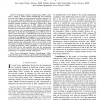Free Online Productivity Tools
i2Speak
i2Symbol
i2OCR
iTex2Img
iWeb2Print
iWeb2Shot
i2Type
iPdf2Split
iPdf2Merge
i2Bopomofo
i2Arabic
i2Style
i2Image
i2PDF
iLatex2Rtf
Sci2ools
TWC
2008
2008
Beam Selection Strategies for Orthogonal Random Beamforming in Sparse Networks
Abstract--Orthogonal random beamforming (ORB) constitutes a mean to exploit spatial multiplexing and multi-user diversity (MUD) gains in multi-antenna broadcast channels. To do so, as many random beamformers as transmit antennas (M) are generated and on each beam the user experiencing the most favorable channel conditions is scheduled. Whereas for a large number of users the sum-rate of ORB exhibits an identical growth rate as that of dirty paper coding, performance in sparse networks (or in networks with an uneven spatial distribution of users) is known to be severely impaired. To circumvent that, in this paper we modify the scheduling process in ORB in order to select a subset out of the M available beams. We propose several beam selection algorithms and assess their performance in terms of sum-rate and aggregated throughput (i.e., rate achieved with practical modulation and coding schemes), along with an analysis of their computational complexity. Since ORB schemes require partial c...
| Added | 16 Dec 2010 |
| Updated | 16 Dec 2010 |
| Type | Journal |
| Year | 2008 |
| Where | TWC |
| Authors | José López Vicario, Roberto Bosisio, Carles Antón-Haro, Umberto Spagnolini |
Comments (0)

